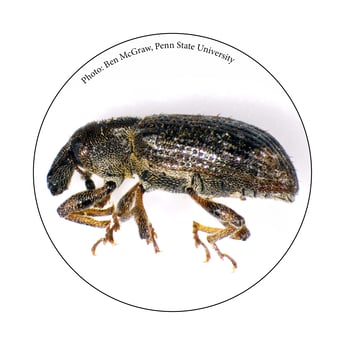Multiple growth stages and weather can make predicting and tracking ABW progress tricky
The annual bluegrass weevil (Listronotus maculicollis) is a major pest of concern for those managing annual bluegrass (Poa annua) as a desired turf. Like any insect, ABWs have multiple growth stages largely dependent on temperatures over time which can make keeping tabs on them difficult from one year to the next.
- Growth Stages: Adults typically spend the winter in taller grass or leaf litter in wooded areas, and begin migrating on foot towards the shorter grass where they will congregate, mate, and lay eggs. Once hatched, the first larval stage (L1) enters turf stems where it will feed internally until it emerges at stage L2.5 - L3 to feed externally. Most of the damage occurs from L4 and L5 larval stages before they pupate and emerge as a second wave of adults. This entire progression may take more than 10 weeks from start to finish, and effective IPM product options are largely dependent on where the majority of the ABWs are in their development.
- Indicator Plants: Since ABWs are small and most of the growth stages are hidden, a number of more obvious plant indicators that typically coincide with critical timings have been adopted to help keep tabs on where the ABWs are likely to be in their cycle. Forsythia, a common landscape plant, can be used to estimate 2 of these critical periods. Adult emergence from their overwintering areas typically coincides with full bloom, and by the time blooms are fading and leaves are developing (50% bloom/50% leaves), ABW adults are usually at their peak in the short turf areas. Medium (L2.5-L3) larvae emerge to feed externally around the time when Catawba rhododendrons are in full bloom. This plant can be thought of as a “last chance” reminder that damage is likely to become evident soon if ABW have not been prevented.

- Scouting: Scouting for adults can be as simple as checking green and tee mower catch baskets for their presence, as they are often swept up by reels. Vacuum sampling and soap flushes will also pull adults from higher turf such as fairways. Pitfall traps placed between overwintering areas and maintained turf areas can gauge when the peak of adult migration has occurred. Pulling some small plugs and closely inspecting them may reveal external-feeding larvae, but breaking them up and submerging in a saturated salt water solution will float even internal-feeding larvae to the surface after an hour. In any of these techniques, keeping records of counts by each method and area will allow for tracking progress and/or assessing the IPM efforts already applied.
- Growing Degree Days (GDD): More and more turf pest and maintenance issues are being tracked and predicted by use of GDD-based models, and ABW are no exception. GDD tracks the relative accumulation of time over which temperatures are above a baseline. This GDD figure can be used to establish a range over which a certain developmental landmark can be predicted to occur. A number of state extension services provide GDD data and trackers for free, and site-specific tracking can also be monitored with weather stations. According to Cornell University, ABW developmental stages typically occur in the following base-50 GDD ranges:
- Adult Peak Migration: 110-120 GDD50F
- Eggs/Small Internal-Feeding Larvae: ~ 175 GDD50F
- Larvae Emerging from Stems: ~ 350 GDD50F
- Consultants and Networks: Timely updates for ABW season can be found online from a number of manufacturer and state extension trackers, blogs, email lists, and social media posts. Some are broad and others can be tailored for more specific regions. There are also some very knowledgeable independent consultants that can even perform on-site assessments and help custom tailor your ABW program. Perhaps the best way to keep a finger on the ABW pulse for your course is to incorporate an ‘All of the above” approach to help ensure staying several steps ahead of this most damaging insect pest in the NE golf industry.
Subscribe to our website and follow Quali-Pro on Facebook & Twitter for promotions, product launches, product info and much more!


